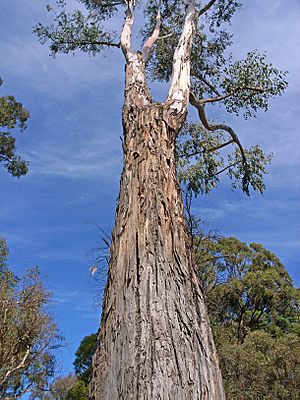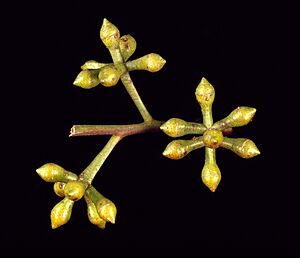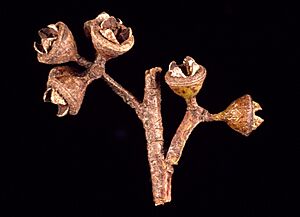Dunn's white gum facts for kids
Quick facts for kids Dunn's white gum |
|
|---|---|
 |
|
| Eucalyptus dunnii in the ANBG | |
| Scientific classification | |
| Genus: |
Eucalyptus
|
| Species: |
dunnii
|
Eucalyptus dunnii, often called Dunn's white gum or just white gum, is a special tree found only in eastern Australia. It's a medium to tall tree. You can spot it by its rough bark near the bottom. Higher up, the bark is smooth and white or cream-colored. This tree has long, curved leaves, flower buds that grow in groups of seven, white flowers, and fruit shaped like a cup or cone.
Contents
What Does Dunn's White Gum Look Like?
Dunn's white gum trees can grow very tall, sometimes up to 50 m (160 ft) high! That's like a 16-story building. It also has a special woody swelling at its base called a lignotuber. This helps the tree regrow if it gets damaged, for example, by a bushfire.
Its Bark
The bark on the lower part of the tree trunk is rough. It can be greyish, corky, or flaky. But as you look higher up, the bark becomes smooth. This smooth bark is white or grey and peels off in short ribbons.
Its Leaves
Young Dunn's white gum plants have leaves that are egg-shaped or almost round. These leaves are about 25–150 mm (0.98–5.91 in) long and 18–110 mm (0.71–4.33 in) wide. They grow in pairs opposite each other on the stem.
As the tree gets older, its leaves change. Adult leaves are long and curved, like a spearhead. They are shiny green on both sides. These leaves are usually 80–300 mm (3.1–11.8 in) long and 15–40 mm (0.59–1.57 in) wide. Each leaf has a stalk, called a petiole, which is about 14–45 mm (0.55–1.77 in) long.
Its Flowers and Fruit
The flower buds of Dunn's white gum grow in groups of seven. They appear in the axils (the angle between a leaf and the stem). Each group of buds sits on a flat stalk called a peduncle, which is about 7–16 mm (0.28–0.63 in) long. Each individual bud has its own tiny stalk, called a pedicel, about 2–6 mm (0.079–0.236 in) long.
When the buds are ready, they are oval-shaped, about 6–7 mm (0.24–0.28 in) long and 3–5 mm (0.12–0.20 in) wide. They have a cap, called an operculum, which can be pointed, cone-shaped, or rounded. The flowers themselves are white.
After the flowers, the tree produces woody fruit. These fruits are like small capsules, shaped like a cup, cone, or half-sphere. They are about 4–6 mm (0.16–0.24 in) long and 5–9 mm (0.20–0.35 in) wide.
Where Does Dunn's White Gum Come From?
The scientific name for this tree, Eucalyptus dunnii, was first given in 1905. It was named by a botanist named Joseph Maiden. He described the tree in a scientific paper called Proceedings of the Linnean Society of New South Wales.
The tree was named dunnii to honor William Dunn. He was the person who first collected a sample of this tree near "Acacia Creek" in the Macpherson Range. This sample helped scientists officially identify and name the species.
Where Does Dunn's White Gum Grow?
Dunn's white gum is found in specific areas of eastern Australia. It grows in wet forests. You can find it scattered in places north of Dorrigo and Coffs Harbour in New South Wales. It also grows up to Warwick and Canungra in Queensland.



